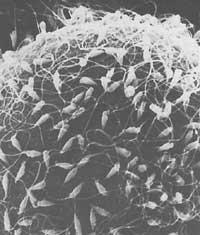Mouse genome encyclopedia increases by 12,400 genes
2001/02/08 Carton Virto, Eider - Elhuyar Zientzia
Finding genes is not an easy task. In June of last year the draft human genome was presented to the world and before the fly Drosophila melanogaster. Since then, the genome map of the Arabidopsis thaliana plant has been completed. Sometimes more accurate information has been obtained than others, but all have worked the same way: The route chosen is to define the sequence of the DNA chain and identify the genes.

The next great job is to know which proteins contain information to synthesize these genes. In fact, proteins are the body workers and the biggest step will be when we know what work each one does. Genes are only instructions for making proteins.
Alternative methodology
Among genes, DNA and proteins is a mediator: RNA messenger. Proteins are synthesized in ribosomes, in cell factories, but DNA is in the nucleus of the cell and cannot be extracted from it. Therefore, a messenger is needed to move the instructions to make the protein. This work is done by the RNA messenger. How? A copy of the gene, the messenger RNA, is made in the nucleus and goes to the ribosomes to synthesize the protein.
In addition to demonstrating that life is amazing, it offers a unique path to genetic research. Messenger RNAs are accurate and clear copies of genes that contain all the information needed to synthesize proteins. They are therefore the ideal means to identify genes.
The Japanese Institute of Physical and Chemical Research (RIKEN) is using this methodology to complete the mouse genome. What they do is catch, clone, group and identify RNA mouse messengers. They have prepared 127,000 clones and have already analyzed 21.076.
8,200 unknowns
After discarding the repeats, they have managed to identify 15,200 genes: 2,800 were already known, but the remaining 12,400 were not. In addition, some 8,200 of the new ones are new not only in the mouse, but also in mammals. The journal Nature today announced that among the genes identified are several key genes in the embryo development phase, as well as some potentially related to cancer.
RIKEN has all the genes collected in a public encyclopedia available to those in need. After the identification of genes, last year a large congress was held with the aim of determining its possible functions and in September this year another 20,000 genes will be held. In fact, the results of that congress are those published today. Its goal is to complete the Mouse Genome Encyclopedia as a tool for binding genes and proteins.
Why the mouse?
Why have you chosen the encyclopedia of the mouse and not that of the man directly? One may ask. For different reasons. In particular, because collecting mouse samples is simpler than collecting in humans, since mice samples can be collected at all stages of development and those of humans no. In addition, the mouse and the man have very similar genomes and the mouse is a very appropriate model for the human being. Therefore, they are used in all researches related to medicine. Therefore, the formation of the mouse genome can be very useful for humans. On the one hand, because homologous genes can have homologous functions and, on the other, because they can facilitate the development of more suitable mouse models. When the remedies for a human disease in mice are tested, it is advisable that man be as faithful as possible. With genomes in hand, it is possible to prepare a mouse model with the same symptoms and responses as man.
Published in the newspaper

Gai honi buruzko eduki gehiago
Elhuyarrek garatutako teknologia




